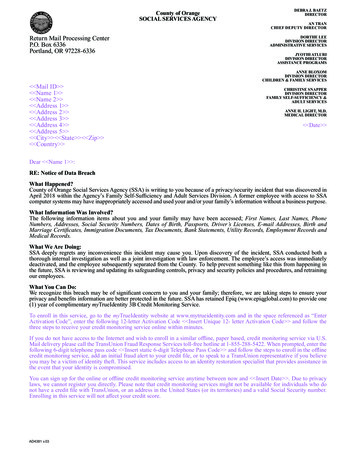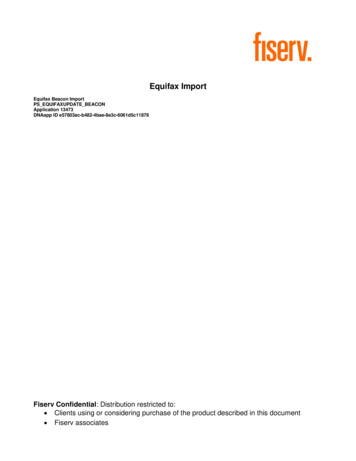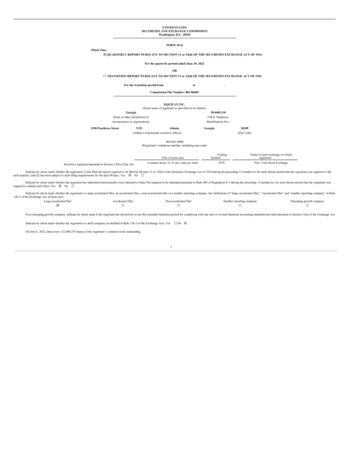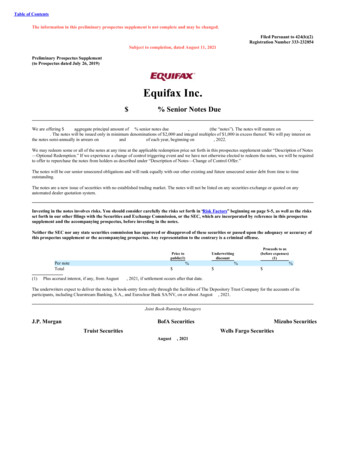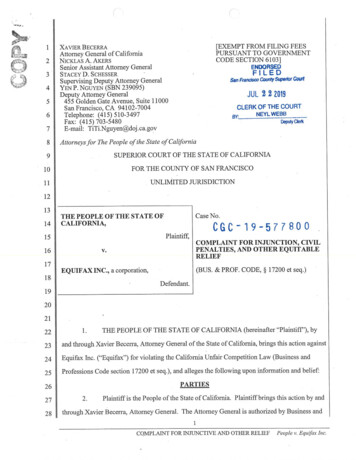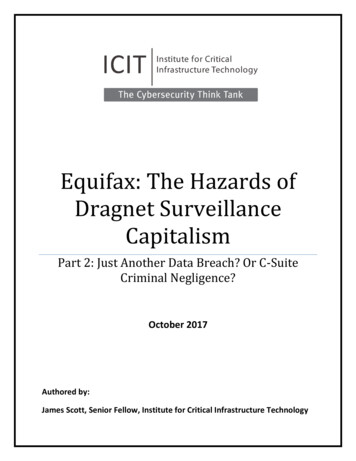
Transcription
Equifax: The Hazards ofDragnet SurveillanceCapitalismPart 2: Just Another Data Breach? Or C-SuiteCriminal Negligence?October 2017Authored by:James Scott, Senior Fellow, Institute for Critical Infrastructure Technology
1Equifax: The Hazards of Dragnet Surveillance CapitalismPart 2: Just Another Data Breach? Or C-Suite CriminalNegligence?October 2017Authored by: James Scott, Sr. Fellow, ICITExcept for (1) brief quotations used in media coverage of this publication, (2) links to thewww.icitech.org website, and (3) certain other noncommercial uses permitted as fair use under UnitedStates copyright law, no part of this publication may be reproduced, distributed, or transmitted in anyform or by any means, including photocopying, recording, or other electronic or mechanical methods,without the prior written permission of the publisher. For permission requests, contact the Institute forCritical Infrastructure Technology.
2Support ICITInformation should be liberated, not commoditized.This powerful philosophy is the bedrock of the Institute for Critical Infrastructure Technology(ICIT), a nonprofit, nonpartisan 501(c)(3) cybersecurity think tank located in Washington, D.C.Through objective research, publications and educational initiatives, ICIT is cultivating a globalcybersecurity renaissance by arming public and private sector leaders with the raw, unfilteredinsights needed to defend our critical infrastructures from advanced persistent threats,including cyber criminals, nation states, and cyber terrorists.Financial capital from generous individual and corporate donors is the lifeblood of the instituteand a force multiplier to our efforts. With your support, ICIT can continue to empower policymakers, technology executives, and citizens with bleeding-edge research and lift the veil fromhyper-evolving adversaries who operate in the dark. Together, we will make quantum leaps inthe resiliency of our critical infrastructures, the strength of our national security, and theprotection of our personal information.http://icitech.org/support-icit/
3ContentsAbstract . 4Introduction . 4The Equifax Breach Was an Inexcusable Travesty . 5Background . 6There Is a Difference Between Consumer and Commodity . 7No Matter the Actual Attribution, Attackers Will Exploit Consumer Data . 8“The Fish Rots From the Head” . 9Public Outcry Can Reverse the System . 11Legislators Can Rein in Negligent Data Brokers . 12Action Is Necessary While Equifax’s Example Remains Fresh . 13
4AbstractThe reckless handling of data collected in capitalistic dragnet surveillance has developed into anational security and privacy epidemic. The Equifax breach, in which attackers exfiltrated thecredit records of 143 million Americans, is an inexcusable travesty that resulted from systemicnegligence and the irresponsible actions of senior executives. The company and its C-suiteexecutives should not be permitted to simply cash in their insurance or pensions and then moveon, while 44 percent of the nation has to change microscopic aspects of their daily lives toremain vigilant against lurking adversaries, despite never authorizing Equifax to collect, retain,or exchange their data. Rather than passing the brunt of the impact onto consumers, Equifax andits executives must be held accountable for their failure to secure consumer data according to itsvalue, so that other data brokers and the American public understand that organizational actionsthat jeopardize the security and privacy of the public and the nation will not be allowed tocontinue without consequence.IntroductionFew things are certain in the emerging cyber-kinetic-meta-war; however, one absolute is thatcapitalistic dragnet surveillance, formerly a privacy issue, has metastasized into a nationalsecurity epidemic. The breach of Equifax, one of the largest data brokers, resulted in the loss ofcredit record portfolios of 143 million Americans, nearly 44 percent of the population. Equifaxbotched even fundamental incident response procedures repeatedly. Instead of focusing onmitigating the potential harm to consumers and businesses, Equifax executives spent nearly sixweeks conspiring machinations to lobby for the removal of consumer protections, to profit fromvictims through “free” credit monitoring and identity theft services, and to trick averageAmericans into relinquishing their rights to pursue legal action against Equifax. Equifax and itsexecutives should be held accountable for their failure to safeguard consumer data according toits value.Few things are certain in theGiven the nearly infinite capabilities of artificialintelligence and machine learning, malicious threat emerging cyber-kinetic-meta-war;actors will be able to leverage the stolen Equifaxhowever, one absolute is thatcredit records and metadata exfiltrated from othercapitalistic dragnet surveillance,sources in potent multivector cyber-kinetic-metaformerly a privacy issue, haswarfare attacks against critical infrastructurepersonnel and average consumers for years ormetastasized into a national securitydecades. The realistic best-case scenario is anepidemic.onslaught of identity theft, credit profilemanipulation, rampant tax fraud and health sectorfraud. More likely though, sophisticated adversaries will utilize the information topsychographically target vulnerable critical infrastructure executives and congressional
5employees with elevated privileges psychographically in precision-tailored social engineeringcampaigns that deliver malware or ransomware onto sensitive systems or that result in theexfiltration of intellectual property or classified intelligence.In regard to the Equifax breach, ICIT has received more briefing requests from Congress, federalagencies, and domestic and international law enforcement than it has on multiple other recentmajor topics combined, including election hacking, Russian attempts to undermine democraticinstitutions, the OPM breach and the Anthem breach. Approximately 44 percent of the UnitedStates population had their credit records compromised, and victims are experiencing panic andfear as they begin to comprehend how potent tailored psychographic attacks can be whenadversaries leverage the stolen Equifax files. Data brokers must understand that willful ignoranceof cybersecurity and cyber-hygiene cannot be allowed to continue. Consumers’ data are morethan just commodities. Each loss impacts lives directly. Through its calamitous failures, Equifaxhas distinguished itself as the prime example.Equifax should live on only in infamy, just as Enron remains an Consumers’ data are moreexample of dishonest business practices. Equifax shouldthan just commodities. Eachepitomize the consequences of negligent data brokerage.loss impacts lives directly.Equifax systems can no longer be trusted. The integrity of thedata in its possession has been compromised. The informationcannot be regarded as authentic because adversaries could have altered, removed, or addeddetails without Equifax’s knowledge. Its “Frankensteined” architectonic labyrinth of an IoTmicrocosm is prototypical of the vulnerable networks, managed by unqualified informationsecurity personnel, that support every major data broker.The Equifax Breach Was an Inexcusable TravestyThe Equifax breach is more substantial than previous disastrous incidents at Target, HomeDepot, Yahoo, and other companies, because the consumer data housed within Equifax systemsare more substantial than just credit card information. Consumers can cancel a compromisedcredit card [1]. Equifax is a data broker. Its product is aggregated consumer informationcollected from third parties and dragnet surveillance initiatives. The exposed data includedconsumers’ Social Security numbers, birth dates, full names, driver’s license information,purchasing habits, frequented businesses, and other extremely personal information [1] [2].Equifax and third parties leveraged the aggregate data in complex psychographic anddemographic big data algorithms to predict microscopic and macroscopic aspects of individualconsumers and entire groups to assess the credit value of individual consumers and informdecisions about whether they were responsible enough to receive credit, borrow money, or takeout mortgages. [2]. Now, the attacker(s) can also make predictions and assessments of
6consumers’ lives, in addition to compromising financial accounts and stealing identities. Bynecessity of its function, the data sets had to be robust enough to approximate an individual’slife. Now the lives of 143 million Americans are in the hands of an unknown malicious threatactor. At any time in the next few days to the next few decades, that adversary could sell ordisclose the data publicly and inflict severe short-term and long-term harm on approximately 44percent of the United States population [2].BackgroundOn July 29, 2017, Equifax discovered that for at least two months, a remote adversary hadexploited an unpatched Apache Struts vulnerability (CVE-2017-5638) and exfiltrated thesensitive extensive credit record information of 143 million Americans. The credit cardinformation of 209,000 consumers was also exposed. Definitive details of the attack are stillemerging, but some postulate that the attackers may have discovered vulnerable Equifax serversvia Shodan or that they may have piggybacked off of affiliated banking networks andcompromised Equifax’s system laterally [2] [3]. A patch for CVE-2017-5638 was madeavailable publicly on March 7, 2017, at least two months before the breach; however, negligentsystem administrators within Equifax failed to apply the patch to the vulnerable systems.The breach was not disclosed to the public untilThe offered TrustedID creditSeptember 7, 2017. Equifax claims that it spent themonitoring service auto-renewsintervening time working with a cybersecurity consultantand authorities; however, in that time, Equifax amendedfor a fee after the first year.its terms and conditions to reduce legal liability, lobbiedEquifax will thereby profitagainst victim breach protections, and planned initiativesfrom its victims in the future.that exploited victims of the breach further or forcedthem to sign away their ability to litigate. Overwhelmingpublic outcry has since compelled Equifax to retract its claim over victim arbitration rights andoffer free credit monitoring and credit freezes for a year. It should be noted that the risk tovictims will likely last decades. The offered TrustedID credit monitoring service auto-renews fora fee after the first year. Equifax will thereby profit from its victims in the future.Equifax relied on a haphazardly designed website for its breach response. The site proved unableto report accurately whether consumers were victims of the breach [4]. Some users reported thatthe site accepts fake information or gives differing results for the same input. Its name,equifaxsecurity2017.com, resembled the naming schema of phishing sites. The site was initiallyblocked by some malware prevention services, such as OpenDNS [2]. Further, Equifax’s Twitteraccount directed users accidentally to a malicious watering-hole [4].
7There Is a Difference Between Consumer and CommodityConsumers choose whether to frequent Target or Home Depot. If a store is impacted by anincident or revealed to practice poor cybersecurity and cyber-hygiene, consumers can frequent acompetitor instead. Most citizens have never used Equifax’s products. They receive no economicincentive in exchange for their data, and they have little or no control over how Equifax uses thatdata. Simply put, American citizens are not Equifax customers; they are its product. Through thecapitalization of dragnet surveillance and the employment of psychographic and demographicBig Data algorithms, organizations like Equifax have monetized nearly every aspect ofindividuals’ identities. It is estimated that together, Equifax, Experian, and TransUnion collectmore than 4.5 billion new pieces of consumer data each month. As consumers age, so too growsthe lists of addresses, PII, utility accounts, telephone subscriptions, criminal records, medicaldebts, housing histories, and other information. To an extent, for-profit credit bureaus likeEquifax have more control over whether a consumer “qualifies” for credit, a mortgage, or a loan,than the applicant does. Citizens and financial institutions alike cannot opt out of the credit reportsystem that private credit bureaus have superimposed over critical infrastructure sectors [4].The OPM breach was a cyber-Pearl-Harbor[Consumers] receive no economicthat shook the nation and invited publicincentive in exchange for their data,outrage, numerous investigations,Congressional inquiries, and widespreadand they have little or no control overreformation of critical infrastructurehow Equifax uses that data. Simply put,cybersecurity. The breach galvanized publicAmerican citizens are not Equifaxand private organizations momentarily tocustomers; they are its product.improve their security posture and protecttreasure troves of sensitive data according totheir value. OPM was compromised because it lacked the resources and knowledgeableemployees to protect its systems [5]. Equifax is not comparable to OPM in anything but itscatastrophic short-term and long-term impacts on national security and its organization’s refusalto invest in qualified information security personnel for vital decision-making roles. Equifax isnot OPM. OPM had limited resources to secure obsolete legacy systems and hire informationsecurity personnel [5]. Equifax has an annual revenue exceeding 3 billion [2]. It could haveafforded to hire multiple information security teams to assess risk perpetually and implementpolicies, procedures, and controls to mitigate threats and remediate compromises beforeconsumers were harmed. Equifax knowingly and continuously failed to protect data according toits value or potential to impact victims if disclosed.The Equifax breach is an inexcusable travesty. Like many other data brokers, the companyeschewed cybersecurity and cyber-hygiene best practices in favor of short-term savings andprofits, because they assumed either that their investment in modest cyber insurance policies
8would cover the costs of any incidents or that they were too essential to America to be allowed tosuffer severe consequences that resulted from their deliberate negligence. By their estimation,any breaches of data would impact consumers and have only a transitory impact on their bottomline. At the moment, their estimation is moderately accurate. Data brokers do not seem to be heldto the same level of accountability as other businesses. Consider that if a single hospitaljeopardized the well-being of 143 million patients for the next decade, it would not remainoperational and its executives would likely be subject to criminal charges. If a restaurant chaindiscovered that its product posed a risk to nearly half of American consumers and then it decidedknowingly to withhold that information for six weeks so that it could profit and position itself toexploit the victims further, it would not remain operational and its operators would face criminalcharges. The C-level executives of Equifax should at least face investigations and Congressionalinquiry, if not criminal charges, for their absolute disregard for fundamental cybersecurity andcyber-hygiene best practices.No Matter the Actual Attribution, Attackers Will Exploit Consumer DataVerified attribution of the Equifax attack has not been established at the time of this writing.However, since nearly half of the United States population was compromised, citizens and lawenforcement need to be cognizant of attack vectors that different categories of adversaries coulduse with the assistance of the data stolen from Equifax.Numerous script kiddies and cybercriminals have attempted to claim credit to seize fame orpromote products of Deep Web markets and forums. Even if the data exchanged did not originatein Equifax servers, the uptick in sold stolen data will still lead to the exploitation ofcompromised identities in the near future. The media attention attributed to the Equifax breachand the value of the data exfiltrated, combined with the apparent ease of the attack vector, mayinspire waves of unsophisticated attackers and some sophisticated adversaries to target databroker systems.Victims can expect small unauthorized charges to appear on credit cards and bank accountsbefore larger purchases, because attackers often test victims’ vigilance prior to fiscalexploitation. Attackers may open new credit accounts, or they might leverage existing accounts.Because the victims of the Equifax breach are so numerous, the adversary could discard accountsafter a single exploitation and still garner massive profits. Oblivious victims could discover in adecade that one or more attackers were using their information to apply for tens or hundreds ofthousands of dollars in loans. In the long term, identity theft should be a major concern;especially for individuals with credit scores in the mid-700s. This median range is ideal forobfuscating nefarious activity while still enabling massive gains from the attack. Since EHR areoften associated with PII and driver’s license, both of which were exposed by Equifax, victimsshould be wary of medical fraud in the near and distant future. Medical fraud attacks vary fromfalsifying information in attempts to receive prescription drugs to charging expensive surgeriesto the victim’s health insurance.
9Sophisticated adversaries can leverage the Equifax data in psychographic and demographic bigdata algorithms powered by machine learning to identify critical infrastructure personnel whomight be vulnerable to identity theft or blackmail. Employment and shopping histories can revealan employee’s satisfaction with their job, the status of their marriage, their fickleness, and darkerimpulses. Adversaries ranging from cybercriminals to nation-state sponsored advanced persistentthreats (APTs) can leverage the information to compel or coerce critical infrastructure personnelinto operating as insider threats. Given that Equifax employees likely had their datacompromised in the breach, the organization may be rife with disgruntled employees who arejaded about the C-suite’s alleged attempt to improve organizational cybersecurity and cyberhygiene immediately.Even access to the data could prove enough to turn trusted employees into unintentional insiders,as adversaries could leverage PII as possible credentials or recovery questions, or they could usethe information to custom-tailor social engineering lures. Afterward, they can deliver persistentmalware onto the systems and navigate about the network laterally. Senior executives and otherswith privileged credentials are exceedingly high-value targets because of their unparalleledaccess to sensitive systems and their historically poor adherence to cybersecurity and cyberhygiene best practices.“The Fish Rots From the Head”Negligent and unqualified C-level executives are the crux of critical infrastructure cybersecurityand cyber-hygiene. Consider that the OPM breach resulted partially from the prolongedmismanagement of critical infrastructure data systems by severely unqualified personnel. OPMhad limited resources and failed to allocate the funds necessary to hire information securityprofessionals or train staff properly in cybersecurity or cyber-hygiene best practices [5]. Equifaxalso suffered from severe mismanagement;Negligent and unqualified C-levelhowever, as a massively profitable data broker,it lacks any rational justification for theexecutives are the crux of criticalappointment of unqualified candidates to theinfrastructure cybersecurity and cybermost important information security roles in thehygiene.organization.Equifax was informed of the breach on July 29, 2017. On August 1, 2017 and August 2, 2017,three executives sold an estimated 1.78 million in stock [2]. John Gamble, Equifax’s chieffinancial officer, sold 946,374 worth of shares; Joseph Loughran, president of U.S. informationsolutions, disposed of 584,099 worth of stock; and Rodolfo Ploder, president of workforcesolutions, sold 250,458 of stock [3]. The public was not notified for another six weeks. All threeexecutives and Equifax claim that that the sale was a coincidence and that the executives wereunaware of the compromise prior to liquidating the stocks. At first, it appeared that investigationswould be needed to verify the facts surrounding the exchange. It remained possible that theexecutives may have instituted automated periodic liquidation of stocks or that the listings were
10pure coincidence; however, the revelation that Equifax suffered an earlier breach in Marchnegates any semblance of truth [2]. The executives would have been aware of the yet publiclyundisclosed March incident when they sold their stocks in early August. There is only a minimalchance that any of the executives are not in contravention of insider trading laws. Worse,Gamble sold 14,000 shares for 1.91 million on May 23, 2017, immediately after executiveswere notified of the earlier breach.Following immediate public outcry in response to the abysmal response to the breach, CIODavid Webb and CSO Susan Mauldin “retired early” from Equifax. Webb had a background infinancial services organizations. Since his appointment in 2010, he focused on increasingEquifax revenue and growing its business instead of on protecting Equifax’s data or datasubjects. Webb earned a bachelor’s degree in Russian from the University of London and amaster’s degree in business administration from the J.L. Kellogg Graduate School ofManagement at Northwestern University. He did not have formal training in informationsecurity, computer science, or any field prerequisite to the responsibilities of his position.Mauldin, who was tasked with securing consumer data, lacked any semblance of formalcybersecurity training. Mauldin earned a bachelor’s and master’s degree in music compositionfrom the University of Georgia. She was not trained to secure millions of consumer records andinvestigators should question why she was positioned in a vital executive cybersecurity role [2].On September 26, 2017, Equifax announced that its chief executive officer, Richard Smith,would immediately step down. The appointment of Webb and Mauldin was at least partiallydecided by Richard Smith. For 12 years, Smith promoted a profit-first culture within Equifax andtreated responsible cybersecurity and cyber-hygiene as anathema[1]. Smith’s strategy at Equifaxwas to gather as much personal data as possible and find new ways to monetize it constantly.Under his stead, Equifax reportedly released dozens of new products each year and doubledrevenue annually. It increased its stores of data by scrubbing social media algorithmically andpersuading over 7,000 employers to entrust it with the salary details of half of the Americanworkforce. Ironically, Equifax’s pitch to clients promised to safeguard information, and it soldmultiple products to help companies that suffered cyberattacks to protect their customers.Equifax used to purport, “Data breaches are on the rise. Be prepared . You’ll feel safer withEquifax” [4].Smith focused heavily on increasing profit. One former Equifax employee recounts that underSmith, the company was “ run a little more like a sports team. You immediately had to get outthere and perform, and if you didn’t perform, you were cut.” Smith helped expand Equifax into24 countries by acquiring competitors and developing new markets. Teams of data miners andmathematicians focused on developing new analytic products capable of predicting consumerbehaviors in novel ways. The insights of the algorithms were sold as solutions to lenders andother companies. For instance, one such product searched Twitter for keywords like “car,” pairedusers with their credit score, identified potential automotive buyers in real time, and then offeredthose shopper profiles to automotive dealerships [4].
11Despite his focal role in propagating the negligent practices that facilitated the breach and hispivotal part in designing and orchestrating the abhorrent incident response, Richard Smith willstill receive his 18.4 million pension, but will forgo his 2017 bonus and his severance pay.Equifax’s board of directors and senior management team should be held accountable, and theyshould be required to justify their negligent actions that led to the breach publicly. Withoutconsequences, other data brokers will repeat Equifax’s failure in the near future. Richard Smithwas scheduled to testify at a House Energy and Commerce Committee hearing October 3, 2017,and a Senate Banking Committee hearing the following day. Despite stepping down, he is stillexpected to attend at least the House hearing [1].After the breach, Russ Ayres was appointed interim CSO, Mark Rohrwasser was named interimCIO, Paulino do Rego Barros Jr. will serve as interim CEO, and independent member MarkFeidler will serve as non-executive chairman [1] [2]. In the aftermath, the board claims to berefocusing organizational culture around cybersecurity and will consider candidates from outsidethe company for the permanent CEO position. Feidler claims that the board has formed a specialcommittee “to focus on the issues arising from the incident and to ensure that all appropriateactions are taken." Still, Equifax’s response does little to assuage the harm inflicted on nationalsecurity and the general public. Combating identity theft can cost tens of thousands of dollarsdepending on the amount of exposed information, the tenacity of the adversary, and the numberof attackers [1]. Given the granularity of the data exfiltrated from Equifax systems, those costscould be much higher. Working class families cannot afford to combat the malicious adversariescapable of weaponizing the data stolen from Equifax. The company has offered victims a year offree credit monitoring, and it has been pressured to waive credit freeze fees for those impacted.Accessing these inadequate retroactive remediation mechanisms will require citizens to entrusteven more data to Equifax, despite its multiple demonstrations that it cannot be trusted to securedata. Credit monitoring has proven ineffective in the past, and most victims lack the spare timenecessary to sustain credit freezes for prolonged periods. Further, neither offering even remotelycompensates victims for the years of anxiety and potential tens of thousands of dollars ofremediation costs resulting from the incident.Under the current laws, Equifax and similarly compromised organizations are not legallyrequired to cover the costs associated with harm to those whose data was stolen, even if theindividuals never consented to data collection, retention, and exchange. The entire economy willsuffer from decreased productivity and reduced consumption, as individuals and businesses alikebegin to feel the impact that Equifax might avoid suffering if the organization and negligentexecutives are not held accountable for their deliberate actions that jeopardized the security andprivacy of individuals and the nation [11].Public Outcry Can Reverse the SystemEquifax exhibited historically terrible incident response. Cybersecurity researcher Brian Krebsremarked, “I cannot recall a previous data breach in which the breached company’s public
12outreach and response has been so haphazard and ill-conceived.” After the ousting of fiveexecutives and weeks of tumultuous public interfacing, Equifax stock remains down 26 percentat the time of this writing. Regulators, congressional committees, and state attorney generalshave launched investigations. Numerous victim advocacy groups, class-action groups, the city ofSan Francisco, and numerous individuals have all filed suits against Equifax [1].The public needs to demand more fromThe public needs to demand more fromnegligent data brokers than free creditnegligent data brokers than free credit freezesfreezes and a year’s worth of creditmonitoring. For instance, the current creditand a year’s worth of credit monitoring.reporting system enables brokers to profitfinancially from consumer data without necessitating proper security or privacy safeguardssurrounding that data. Data brokers have demonstrated on every occasion that they cannot betrusted to protect data according to its value by default. The system operates backward. Datasubjects are forced to pay brokers, to whom they never authorized the exchange of their data, toaccess, monitor, or freeze their data. Currently, victims lack practically any legal rights over thedata stored in brokers’ systems, ironically because their data is the product sold by brokers.Brokers act as a man-in-the-middle against average Americans. Economic incentives to disclosedata or relinquish privacy rig
The Equifax breach is more substantial than previous disastrous incidents at Target, Home Depot, Yahoo, and other companies, because the consumer data housed within Equifax systems are more substantial than just credit card information. Consumers can cancel a compromised credit card [1]. Equifax is a data broker.


